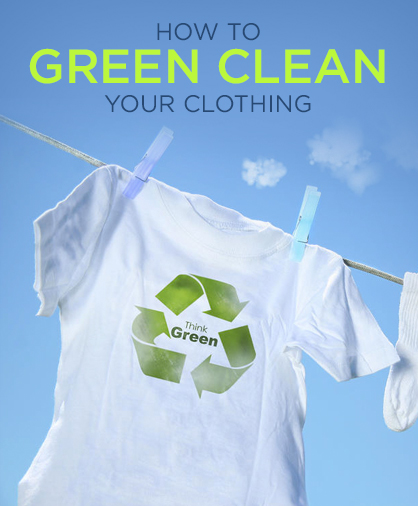12 Tips to Green Clean Your Clothes
Your clothing cleaning habits may need a makeover. The environmental impact of doing laundry is considerable. Think of the energy and water used by your washer and dryer, plus the pollution that results from your dirty laundry water. Each year, the average American household will go through 16,000 gallons of water while using their washer – or 1.28 trillion gallons from the 80 million some consumer washers in the United States. Agree you might need to go a little greener? Read on for our 12 tips on how to clean your clothes while keeping the environment in mind – and save you a pocketful of money on your utility bill.
Line Dry
Five hours of dryer time a week will run you $130 per year in electricity costs. In addition, your dryer can emit more than a ton of carbon dioxide each year. Save energy, money, and wear and tear on your clothes by hanging your clothes up to dry au natural for a nicer smelling clean. Drying clothes in the dryer weakens the garment’s fiber and high-temperature drying can cause cracks in cotton. Plus air-dried clothes iron easier.
Use the Cold Water Cycle
The vast majority (up to 90 percent) of the energy your washing machine expends comes from heating the water. Yet most clothes don’t need hot or even warm water to get them clean. Cold cycles can be just as effective. Some new detergents are even designed for use with cold water. Save up for the occasional hot wash, and try lower temps of 30 to 40 degrees when needed.
Spot Stain
Next time you spill ketchup on your shirt (or whatever stain), soak it in your sink with a pinch of baking soda rather than use chemical products or large amounts of water by washing straight away. Baking soda will make sure the stain doesn’t set.
Choose a Green Detergent
Going planet-friendly in your choice of detergent or laundry soap can be gentler on your clothes as well as the environment. Be wary of labels that proclaim the detergent is organic or green. Check the ingredients, and especially watch for phosphates, surfactants, butyl cellosolve, petroleum, fragrances and triclosan. These days, there is a bounty of eco-friendly detergents and laundry soaps out there that are free from synthetic ingredients. Look for something high efficiency (with a HE label) and try companies such as Seventh Generation, Ecover, Ecos, Bioshield and Naturally Yours. Check the EPA’s website for green brands or the ConsumerSearch. The EPA sponsors a voluntary Design for the Environment Seal for products that meet its environmentally friendly requirements.
Go with a Short Cycle
Some washing machine cycles are half an hour; some are two hours. Unless your clothes are super stained, a short washing cycle should do. Your machine may have an eco option or everyday setting that uses less water and energy.
Maximize Your Dryer
If you have to use a dryer, make sure to maximize its efficiency. Cleaning the lint filter on a regular basis will shorten drying time and reduce your energy bill. Check to see if your dryer has a moisture sensor, which will automatically shut off the machine when the clothes are dry. Lastly, some dryers have a high speed spin option that cuts down on the time clothes need to get dry, saving energy.
Throw Away Dryer Sheets
Dryer sheets are often filled with harmful, cancer-causing chemicals and neurotoxins, including toluene and styrene. These toxic chemicals can break down natural fibers, wearing your clothes out quicker. For an eco-friendly sweet scent, try adding a sachet of dried organic lavender to your dryer.
Use an Eco-Friendly Washer or Dryer
There are models out there that are designed to use less water and power without sacrificing cleanliness. Next time you need to replace your washer – please use it till the end of its life expectancy—consider a green model, such as an energy star washer or a front-loading machine. Not only are front-loading washing machines gentler on clothes than top-loaders (they don’t have an agitator in the middle churning clothes), they use a third less water, energy and detergent. An energy star top loading machine can save 7,000 gallons of water a year.
Try Oxygen Bleach
Made from hydrogen peroxide, oxygen bleach is better on the environment than chlorine bleach; it degrades naturally in oxygen and water. Check your natural foods store for some brands that will keep your clothes just as white.
Hand Wash When Possible
The average washing machine uses 41 gallons of water a load, a great deal more than hand washing. Washing your clothes in the sink saves energy, plus money. Each load of laundry costs $1.42 for energy costs such as heating water.
Wait till You Have a Full Load
Only press the on button when you have accumulated a full load of laundry for peak efficiency. If this is not possible, your machine may have a load size selector option, which will require less water. Dryers can also save energy with the same option.
Green Dry Cleaning
When the washing machine or hand washing doesn’t cut it, take your clothes to a green dry cleaners. The conventional dry cleaners use the toxic perchloroethylene to clean clothes. Look for environmentally sound chemicals and practices, such as liquid carbon dioxide.
Tagged in: green, environment, cleaning, cleaning clothes, dryer, detergent, green clean, washing machine, eco-friendly,

LadyLUX



